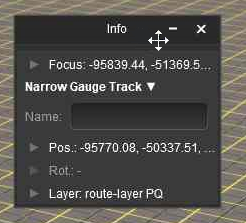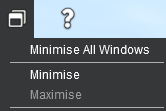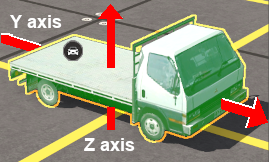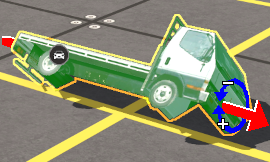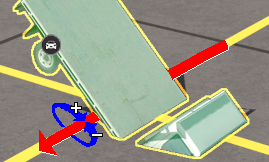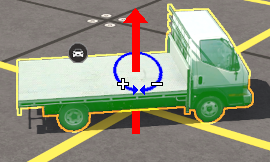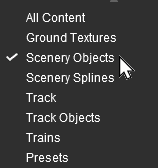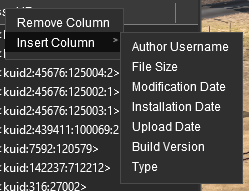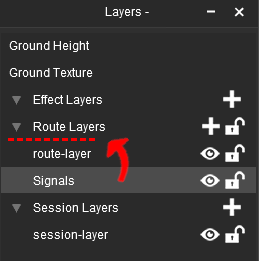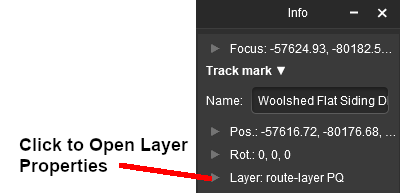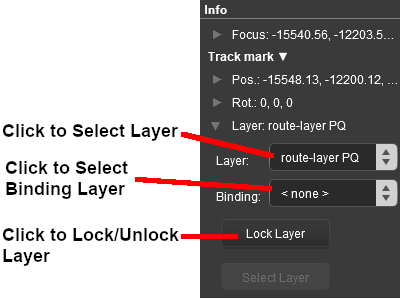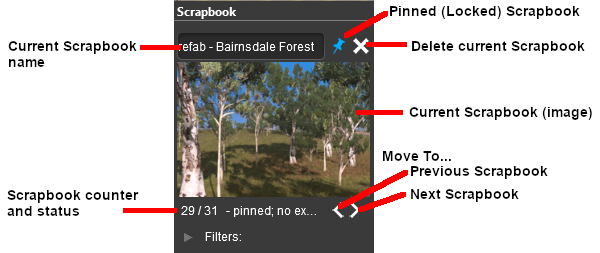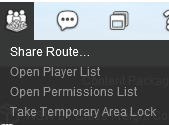How to Use S20 Palettes
m (→Rotation Info and Controls) |
m |
||
| Line 1,048: | Line 1,048: | ||
<tr valign="top"> | <tr valign="top"> | ||
<td width=629><span id="skip Layer Info and Controls"></span> | <td width=629><span id="skip Layer Info and Controls"></span> | ||
| − | |||
=='''Layer Info and Controls'''== | =='''Layer Info and Controls'''== | ||
</td> | </td> | ||
| Line 1,168: | Line 1,167: | ||
<tr valign="top"> | <tr valign="top"> | ||
<td>[[image:Stop.PNG|link=]]</td> | <td>[[image:Stop.PNG|link=]]</td> | ||
| − | <td><span style="font-size: 15px; font-weight: 700;"> | + | <td><span style="font-size: 15px; font-weight: 700;">Warning:</span> |
<table> | <table> | ||
<tr valign="top"> | <tr valign="top"> | ||
<td width=10>[[image:DotPoint.JPG|10px|link=]]</td> | <td width=10>[[image:DotPoint.JPG|10px|link=]]</td> | ||
| − | <td>Setting a layer for multiple objects that are in different layers will move ALL those objects to that layer</td> | + | <td>Setting a layer for multiple objects that are in different layers will move '''ALL''' those objects to that layer</td> |
</tr> | </tr> | ||
<tr valign="top"> | <tr valign="top"> | ||
| Line 1,383: | Line 1,382: | ||
</tr> | </tr> | ||
</table> | </table> | ||
| − | <table bgcolor=#000000 | + | <table bgcolor=#000000 cellpadding=2> |
<tr valign="top"> | <tr valign="top"> | ||
<td> | <td> | ||
| − | <table bgcolor=#ffffb0 | + | <table bgcolor=#ffffb0 cellpadding=2> |
<tr valign="top"> | <tr valign="top"> | ||
<td width=25>[[image:NotePad.PNG|link=]]</td> | <td width=25>[[image:NotePad.PNG|link=]]</td> | ||
| Line 2,603: | Line 2,602: | ||
<tr valign="top"> | <tr valign="top"> | ||
<td>[[image:Stop.PNG|link=]]</td> | <td>[[image:Stop.PNG|link=]]</td> | ||
| − | <td><span style="font-size: 15px; font-weight: 700;"> | + | <td><span style="font-size: 15px; font-weight: 700;">Warning:</span><br> |
Setting both a large <span style="font-weight: 700; font-size: 15px; color: gold; background-color: black;"> Radius </span> and a small <span style="font-weight: 700; font-size: 15px; color: gold; background-color: black;"> Scale </span> will cause performance issues</td> | Setting both a large <span style="font-weight: 700; font-size: 15px; color: gold; background-color: black;"> Radius </span> and a small <span style="font-weight: 700; font-size: 15px; color: gold; background-color: black;"> Scale </span> will cause performance issues</td> | ||
</tr> | </tr> | ||
| Line 2,666: | Line 2,665: | ||
<br> | <br> | ||
<span style="font-weight: 700; font-size: 15px;">Steps:</span><br> | <span style="font-weight: 700; font-size: 15px;">Steps:</span><br> | ||
| + | [[image:DotPoint1.JPG|link=]] The first filter option controls where the filters are applied. | ||
<table width=1000> | <table width=1000> | ||
<tr valign="top"> | <tr valign="top"> | ||
| Line 2,671: | Line 2,671: | ||
<td> | <td> | ||
<table width=785> | <table width=785> | ||
| − | |||
| − | |||
| − | |||
<tr valign="top"> | <tr valign="top"> | ||
<td width=350>The top drop down box will provide three actions:-<br> | <td width=350>The top drop down box will provide three actions:-<br> | ||
| Line 2,706: | Line 2,703: | ||
<table width=781 bgcolor=#ffffff> | <table width=781 bgcolor=#ffffff> | ||
<tr valign="top"> | <tr valign="top"> | ||
| − | <td | + | <td> |
| + | <table> | ||
| + | <tr valign="top"> | ||
| + | <td><span style="font-weight: 700; font-size: 15px; color: white; background-color: black;"> Filter List </span></td> | ||
<td>this action will have no effect on the operation of the tool selected in the '''Tool Palette''' or on the objects displayed on the screen in the '''Trainz World'''. It is the default setting and the search results of the entered filters will be shown in the '''Assets Palette''' asset name list below the filters.</td> | <td>this action will have no effect on the operation of the tool selected in the '''Tool Palette''' or on the objects displayed on the screen in the '''Trainz World'''. It is the default setting and the search results of the entered filters will be shown in the '''Assets Palette''' asset name list below the filters.</td> | ||
| + | </tr> | ||
| + | </table> | ||
| + | </td> | ||
</tr> | </tr> | ||
<tr valign="top"> | <tr valign="top"> | ||
| − | <td><span style="font-weight: 700; font-size: | + | <td> |
| + | <table> | ||
| + | <tr valign="top"> | ||
| + | <td><span style="font-weight: 700; font-size: 15px; color: white; background-color: black;"> Filter Selection </span></td> | ||
<td>this action will restrict the selected tool (e.g. '''The Placement Tool''') to only working on those objects that are in the filtered list. Objects that are not in the filtered list will still be visible in the '''Trainz World''' but cannot be selected.</td> | <td>this action will restrict the selected tool (e.g. '''The Placement Tool''') to only working on those objects that are in the filtered list. Objects that are not in the filtered list will still be visible in the '''Trainz World''' but cannot be selected.</td> | ||
| + | </tr> | ||
| + | </table> | ||
| + | </td> | ||
</tr> | </tr> | ||
<tr valign="top"> | <tr valign="top"> | ||
| − | <td><span style="font-weight: 700; font-size: | + | <td> |
| + | <table> | ||
| + | <tr valign="top"> | ||
| + | <td><span style="font-weight: 700; font-size: 15px; color: white; background-color: black;"> Filter Visibility </span></td> | ||
<td>this action will '''hide''' all objects in the '''Trainz World''' that are not in the filtered list. The only exceptions are '''Ground Textures''' and '''Effect Layers''' which will be visible but, unless they are also in the filtered list, cannot be selected.</td> | <td>this action will '''hide''' all objects in the '''Trainz World''' that are not in the filtered list. The only exceptions are '''Ground Textures''' and '''Effect Layers''' which will be visible but, unless they are also in the filtered list, cannot be selected.</td> | ||
| + | </tr> | ||
| + | </table> | ||
| + | </td> | ||
</tr> | </tr> | ||
</table> | </table> | ||
| Line 2,745: | Line 2,760: | ||
</table> | </table> | ||
<br> | <br> | ||
| − | + | <span style="font-weight: 700; font-size: 15px;">Options:</span> Choose from:-<br> | |
| − | <table width= | + | <table width=650> |
<tr valign="top"> | <tr valign="top"> | ||
<td> | <td> | ||
| − | <table width= | + | <table width=300 bgcolor=#0000ff> |
<tr valign="top"> | <tr valign="top"> | ||
<td> | <td> | ||
| − | <table width= | + | <table width=296 bgcolor=#ffffff> |
<tr valign="top"> | <tr valign="top"> | ||
<td width=246 align="center">[[image:Ablue.png|link=]] <span style="font-weight: 700; font-size: 15px; background-color: lightcyan;">Left Click</span> on an asset selection icon<br> | <td width=246 align="center">[[image:Ablue.png|link=]] <span style="font-weight: 700; font-size: 15px; background-color: lightcyan;">Left Click</span> on an asset selection icon<br> | ||
| Line 2,795: | Line 2,810: | ||
<td width=50 align="center"><span style="font-size: 17px; font-weight: 700;">OR</span></td> | <td width=50 align="center"><span style="font-size: 17px; font-weight: 700;">OR</span></td> | ||
<td> | <td> | ||
| − | <table width= | + | <table width=300 bgcolor=#0000ff> |
<tr valign="top"> | <tr valign="top"> | ||
<td> | <td> | ||
| − | <table width= | + | <table width=396 bgcolor=#ffffff> |
<tr valign="top"> | <tr valign="top"> | ||
<td align="center">[[image:Bblue.png|link=]] <span style="font-weight: 700; font-size: 15px; background-color: lightcyan;">Left Click</span> the '''Content Drop-down Box'''<br> | <td align="center">[[image:Bblue.png|link=]] <span style="font-weight: 700; font-size: 15px; background-color: lightcyan;">Left Click</span> the '''Content Drop-down Box'''<br> | ||
| Line 2,817: | Line 2,832: | ||
<tr valign="top"> | <tr valign="top"> | ||
<td width=25>[[image:DotPoint3.JPG|link=]]</td> | <td width=25>[[image:DotPoint3.JPG|link=]]</td> | ||
| − | <td>The third filter is also optional. You can enter a string of text characters that will be used to search the asset names and their descriptions for a match. Those assets that return a positive match, together with a positive asset type, will be shown in the filter name list.</td> | + | <td>The third filter is also '''optional'''. You can enter a string of text characters that will be used to search the asset names and their descriptions for a match. Those assets that return a positive match, together with a positive asset type, will be shown in the filter name list.</td> |
</tr> | </tr> | ||
</table> | </table> | ||
| Line 2,970: | Line 2,985: | ||
</tr> | </tr> | ||
<tr valign="top"> | <tr valign="top"> | ||
| − | <td width= | + | <td width=20>[[image:DotPoint1.JPG|link=]]</td> |
<td>'''To Move:''' <span style="font-weight: 700; font-size: 15px; background-color: lightcyan;">Left Click and Drag</span> the column heading left or right to a new position</td> | <td>'''To Move:''' <span style="font-weight: 700; font-size: 15px; background-color: lightcyan;">Left Click and Drag</span> the column heading left or right to a new position</td> | ||
| − | </tr><tr valign="top"> | + | </tr> |
| − | <td >[[image: | + | <tr valign="top"> |
| + | <td width=20>[[image:DotPoint2.JPG|link=]]</td> | ||
<td>'''To Resize:''' <span style="font-weight: 700; font-size: 15px; background-color: lightcyan;">Left Click and Drag</span> the dividing line between two column headings left or right to a reduce or increase the column width</td> | <td>'''To Resize:''' <span style="font-weight: 700; font-size: 15px; background-color: lightcyan;">Left Click and Drag</span> the dividing line between two column headings left or right to a reduce or increase the column width</td> | ||
</tr> | </tr> | ||
| Line 2,987: | Line 3,003: | ||
<table width=371 bgcolor=#ffffff cellpadding=2> | <table width=371 bgcolor=#ffffff cellpadding=2> | ||
<tr valign="top"> | <tr valign="top"> | ||
| − | <td colspan=2><span style="font-weight: 700; font-size: 15px;">Steps:</span></td> | + | <td colspan=2><span style="font-weight: 700; font-size: 15px;">Steps:</span> To sort the data in a column:-</td> |
</tr> | </tr> | ||
<tr valign="top"> | <tr valign="top"> | ||
| Line 3,134: | Line 3,150: | ||
<tr valign="top"> | <tr valign="top"> | ||
<td width=10>[[image:DotPoint.JPG|10px|link=]]</td> | <td width=10>[[image:DotPoint.JPG|10px|link=]]</td> | ||
| − | <td>The | + | <td>The <span style="font-weight: 700; font-size: 15px; color: white; background-color: black;"> Route Layers </span> group, along with the '''Ground Height''', '''Ground Textures''' and '''Effect Layers''', are saved and loaded with the Route</td> |
</tr> | </tr> | ||
<tr valign="top"> | <tr valign="top"> | ||
<td>[[image:DotPoint.JPG|10px|link=]]</td> | <td>[[image:DotPoint.JPG|10px|link=]]</td> | ||
| − | <td>The '''Session | + | <td>The <span style="font-weight: 700; font-size: 15px; color: white; background-color: black;"> Session Layers </span> group, along with any '''Session Rules''' and '''commoditty''' settings, is saved and loaded with the Session. A '''Session Layers''' group, but one without any stored objects and using the Session '''default settings''', will always be present when a Route is loaded without a Session</td> |
</tr> | </tr> | ||
</table> | </table> | ||
| Line 3,261: | Line 3,277: | ||
<tr valign="top"> | <tr valign="top"> | ||
<td>[[image:PencilTips.PNG|link=]]</td> | <td>[[image:PencilTips.PNG|link=]]</td> | ||
| − | <td>While you are free to rename any layers (but not the Layer | + | <td>While you are free to rename any layers (but not the '''Layer Group''' names), it is '''recommended''' that you '''DO NOT''' rename two specific layers:-<br> |
[[image:DotPoint.JPG|10px|link=]] '''route-layer'''<br> | [[image:DotPoint.JPG|10px|link=]] '''route-layer'''<br> | ||
[[image:DotPoint.JPG|10px|link=]] '''session-layer'''<br> | [[image:DotPoint.JPG|10px|link=]] '''session-layer'''<br> | ||
| − | These layers are used to store critical objects (track and track objects in the case of the '''route-layer''' and rolling stock in the case of the '''session-layer'''). Using these two layer names in every route and session can make it easier (and less confusing) to manage those assets. But this is a '''recommendation''' only. | + | These layers are used to store critical objects (track and track objects in the case of the '''route-layer''' and (optionally) rolling stock in the case of the '''session-layer'''). Using these two layer names in every route and session can make it easier (and less confusing) to manage those assets. But this is a '''recommendation''' only. |
</td> | </td> | ||
</tr> | </tr> | ||
| Line 3,281: | Line 3,297: | ||
<tr valign="top"> | <tr valign="top"> | ||
<td>[[image:Stop.PNG|link=]]</td> | <td>[[image:Stop.PNG|link=]]</td> | ||
| − | <td><span style="font-size: 15px; font-weight: 700;"> | + | <td><span style="font-size: 15px; font-weight: 700;">Warning:</span> '''Deleting a Layer will delete every object that has been assigned to that layer''' |
| − | '''Deleting a Layer will delete every object that has been assigned to that layer''' | + | |
</td> | </td> | ||
</tr> | </tr> | ||
| Line 3,363: | Line 3,378: | ||
<tr valign="top"> | <tr valign="top"> | ||
<td>[[image:Stop.PNG|link=]]</td> | <td>[[image:Stop.PNG|link=]]</td> | ||
| − | <td><span style="font-size: 15px; font-weight: 700;"> | + | <td><span style="font-size: 15px; font-weight: 700;">Warning:</span> Moving layers between the '''Session Layers''' and the '''Route Layers''' groups will move the contents of those layers from one group to the other. This will change where the layers and their contents are saved (in the '''route''' or in the '''session''') |
| − | Moving layers between the '''Session Layers''' and the '''Route Layers''' groups will move the contents of those layers from one group to the other. This will change where the layers and their contents are saved (in the '''route''' or in the '''session''') | + | |
</td> | </td> | ||
</tr> | </tr> | ||
| Line 3,449: | Line 3,463: | ||
<tr valign="top"> | <tr valign="top"> | ||
<td width=25>[[image:NotePad.PNG|link=]]</td> | <td width=25>[[image:NotePad.PNG|link=]]</td> | ||
| − | <td><span style="font-size: 17px; font-weight: 700;">Notes: Moving Layers - What Could Possibly Go Wrong?'''</span><br> | + | <td width=995><span style="font-size: 17px; font-weight: 700;">Notes: Moving Layers - What Could Possibly Go Wrong?''' 😀</span><br> |
---- | ---- | ||
</td> | </td> | ||
| Line 3,826: | Line 3,840: | ||
<tr valign="top"> | <tr valign="top"> | ||
<td>[[image:Stop.PNG|link=]]</td> | <td>[[image:Stop.PNG|link=]]</td> | ||
| − | <td><span style="font-size: 15px; font-weight: 700;"> | + | <td><span style="font-size: 15px; font-weight: 700;">Warning:</span> Setting a layer for multiple objects that are in different layers will move '''ALL''' those objects to that layer. If this moves any of them from one layer group to another (such as from the '''Route Layers''' to the '''Session Layers''') then it will change where those objects are saved (in the '''Route''' or in the '''Session''')</td> |
| − | Setting a layer for multiple objects that are in different layers will move ALL those objects to that layer. If this moves any of them from one layer group to another (such as from the '''Route Layers''' to the '''Session Layers''') then it will change where those objects are saved (in the '''Route''' or in the '''Session''')</td> | + | |
</tr> | </tr> | ||
</table> | </table> | ||
| Line 4,930: | Line 4,943: | ||
<tr valign="top"> | <tr valign="top"> | ||
<td>[[image:Stop.PNG|link=]]</td> | <td>[[image:Stop.PNG|link=]]</td> | ||
| − | <td><span style="font-size: 15px; font-weight: 700;"> | + | <td><span style="font-size: 15px; font-weight: 700;">Warning:</span><br> |
If you '''Uninstall''' a package you will also delete any '''Packaged''' assets it contains that may be needed by other assets on your system, such as routes. Packaged assets may (or may not) be found on the '''DLS''' - that is a decision made by the creator of the package. They are not '''Payware''' but come as part of an installed '''DLC''' package. Trainz has no way of knowing if a "packaged" asset it is about to delete had previously been "Installed from the DLS", and could therefore be needed elsewhere, or was only installed with the package.<br> | If you '''Uninstall''' a package you will also delete any '''Packaged''' assets it contains that may be needed by other assets on your system, such as routes. Packaged assets may (or may not) be found on the '''DLS''' - that is a decision made by the creator of the package. They are not '''Payware''' but come as part of an installed '''DLC''' package. Trainz has no way of knowing if a "packaged" asset it is about to delete had previously been "Installed from the DLS", and could therefore be needed elsewhere, or was only installed with the package.<br> | ||
| − | Uninstalling a package can leave you will some (or many) "Missing dependency" error messages. | + | Uninstalling a package can leave you will some (or many) "Missing dependency" error messages. The remedy is to use '''Content Manager''' to first perform a '''DBR''' (database repair) and then download the missing dependencies from the DLS.</td> |
| − | + | ||
| − | The remedy is to use '''Content Manager''' to first perform a '''DBR''' (database repair) and then download the missing dependencies from the DLS.</td> | + | |
</tr> | </tr> | ||
</table> | </table> | ||
Revision as of 11:04, 24 May 2023
The information in this Wiki Page applies to Surveyor 2.0 (S20) as found in Trainz Plus. The original refernce material for this document can be found at Surveyor 2.0 Overview
|
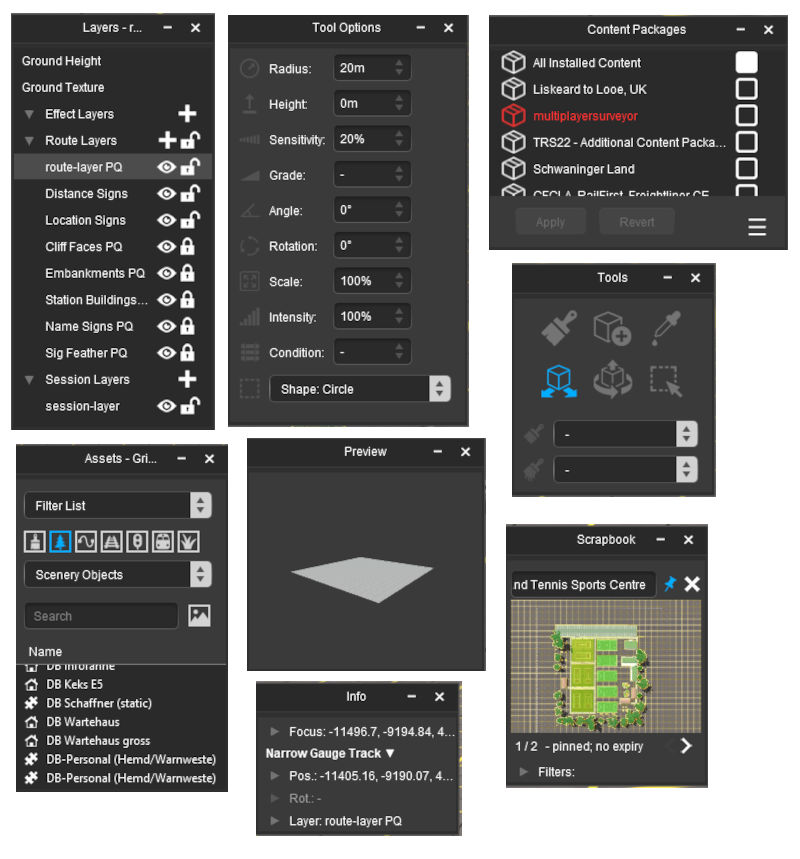 |
The Surveyor 2.0 World |
| When you start Trainz in Surveyor 2.0 the world presented will look something like the following image, but what you actually see can be highly customised to your own preferences. |
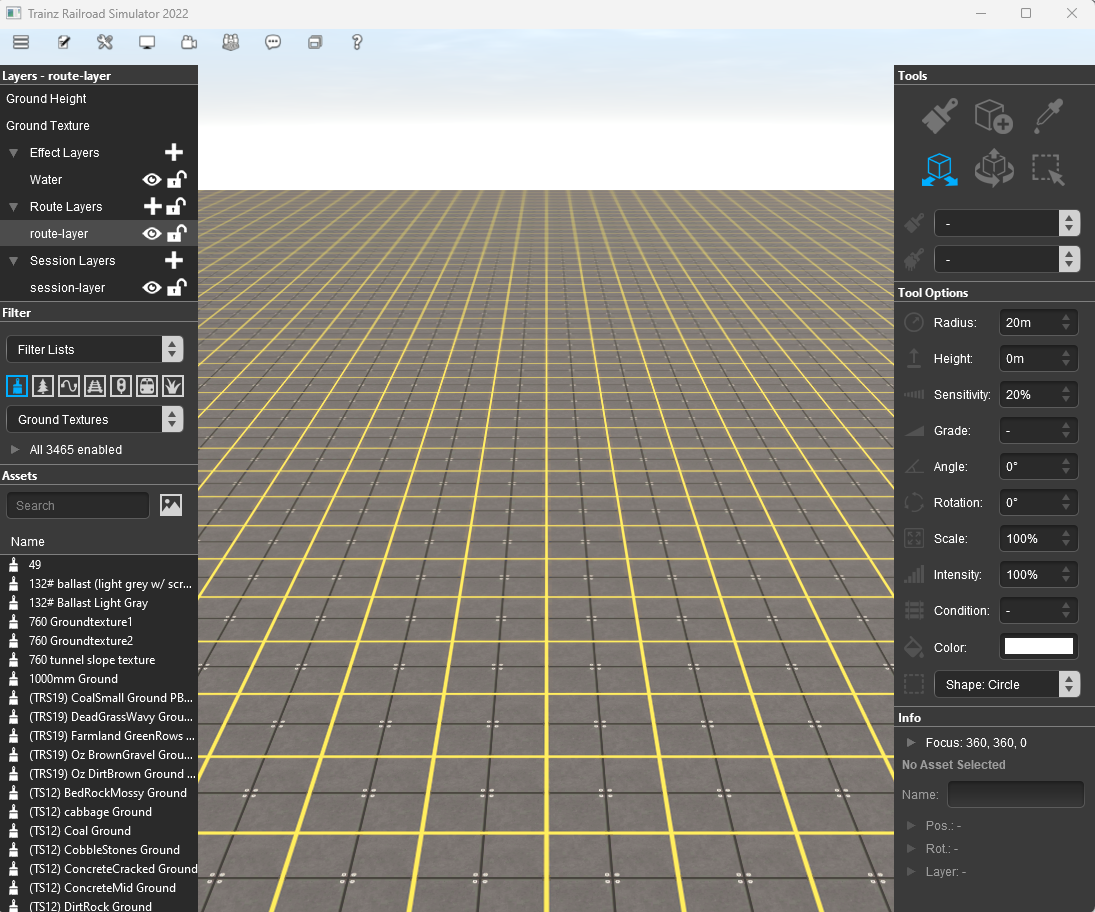
| The dark grey strips on the left and right of the screen contain Palettes that have been Docked into the positions shown. Palettes are where selections can be made, information displayed and controls set. |
|
|
||||||||||||||||||||||
Hiding and Showing Palettes
| Palettes are hidden and revealed using the Surveyor Window Menu. |
|
The 5 visible and 3 hidden Palettes in the screenshot shown above have had their visibility set by:-
|
|
||||||||||||||||||||
Docking and Undocking Palettes
| Palettes are normally Docked, locked into fixed positions on both sides of the Surveyor Screen. They can be Undocked and freed to move anywhere on the screen. |
|
Undocking a Palette
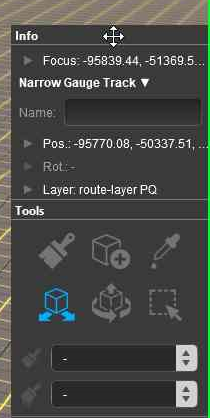 |
|
||||||||||||||||||
Docking a Palette
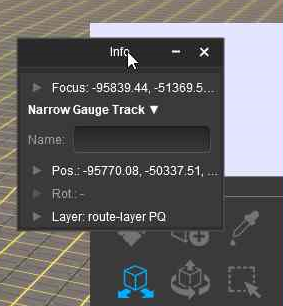 |
|
||||||||||||||||||||
Resizing Palettes
| Only palettes that are Undocked can be resized. Some palettes have to be resized to display all their available information. |
|
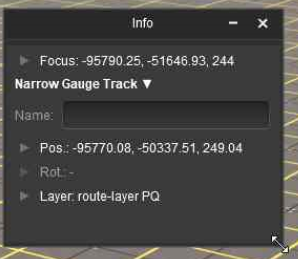 |
|
||||||||||||||||
|
|
||
Minimise Maximise Close
| Minimising will hide a palette or window but retain its size and position data. | |
| Maximising will return it to the screen using its last size and position data. | |
| Closing will hide it but its size and position data will be lost. When next displayed it will be shown docked to the side of the screen. |
The image below shows a Surveyor 2.0 screen with an open window box (the Find Object Tool) and two Undocked palettes (Info and Layers)
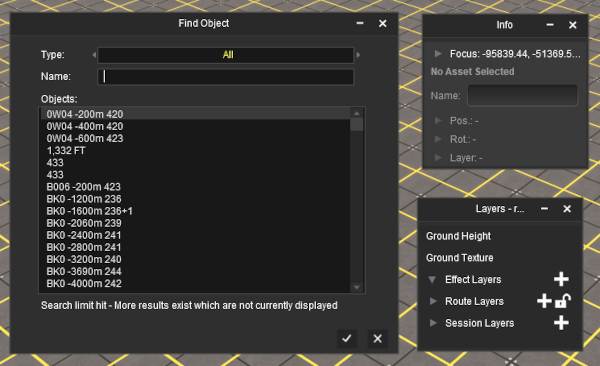 |
|
||||||||||||||||
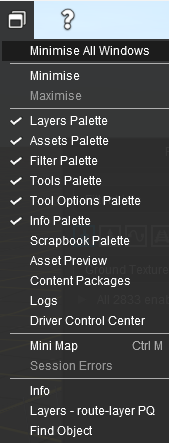 |
|
|||||||||||||
The Info Palette |
|
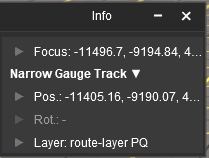 |
|
||||||||||
The components of the Info Palette are identified in the image below.
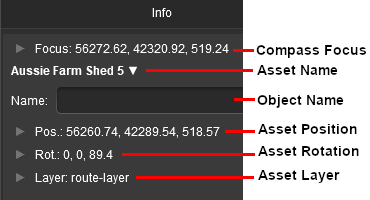 |
Each of the small arrowhead icons will open the palette to display more information and some controls. |
|
||||||||||||||||||
Focus Info and Controls |
| The Focus shows the current position and height of the Cursor object. |
Open up the Focus by a Left Click on its arrowhead icon.
|
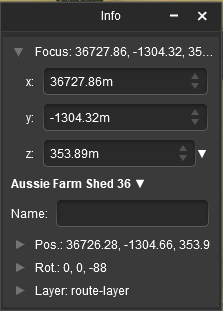 |
|
|
Next to the z co-ordinate is a small white down arrowhead. Left Click on the arrowhead to open its menu.
 |
There is only one option in the sub-menu. Use Height for Brush
|
Asset Name Menu |
You must have an object (or objects) selected for a name to be shown and for this menu to be available.
| If more than one object has been selected then the name and position data shown will be for the last selected object. If different objects (with different kuid codes) have been selected then a count of the additional objects will be added. The (+2) shown in the object name in the image on the left indicates that 2 additional different objects are in the group of selected objects. |
Next to the objects name is a small white Down Arrowhead. Left Click on the arrowhead to open its menu.
 |
The menu options are:-
|
Position Info and Controls |
You must have an object (or objects) selected for the position data to be shown and edited. Open up the position data by a Left Click on its Pos: arrowhead icon.
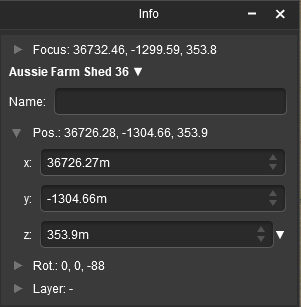 |
The position of the selected object (or the last object if more than one is selected) is shown in the x, y and z text boxes. These values can be edited to move the object or objects to a new position but CARE will be needed.
|
Next to the z co-ordinate is a small white down arrowhead. Left Click on the arrowhead to open its menu.
 |
There is only one option in the sub-menu. Use Height for Brush
|
Rotation Info and Controls |
You must have an object (or objects) selected for the rotation data to be shown and edited. Open up the rotation data by a Left Click on its Rot: arrowhead icon.
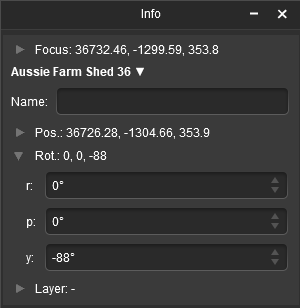 |
The rotational orientation of the selected object (or the last object if more than one is selected) is shown in the r, p and y text boxes (the letters stand for Roll, Pitch and Yaw). These values can be edited to rotate the object or objects in 3D space BUT not all objects can be rotated in certain directions.
|
|
|||||||||||||||||||||||||||||||||||
Layer Info and Controls |
You must have an object (or objects) selected for the layer data to be shown and edited. Open up the layer data by a Left Click on its Layer: arrowhead icon.
|
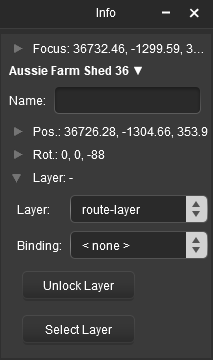 |
This will show the:-
|
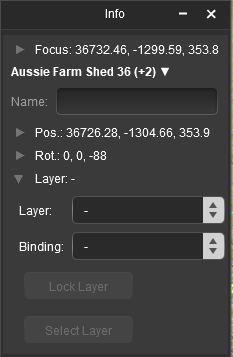 |
If multiple objects from different layers have been selected then no layer name will be shown in the Layer and Binding boxes. Instead they will be left "blank" as shown in the image on the left. Both boxes can still be opened to assign layers to objects.
|
Assigning Objects to a Different Layer |
A selected object or group of selected objects can be assigned to a different layer. If multiple objects have been selected then they do not have to all be in the same layer.
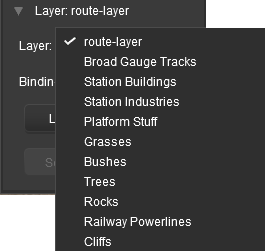 |
|
|||||||||||
Once a target layer has been selected then the Select Layer button, which sets the Active Layer, may become active.
|
|
||||||||||
Assigning Objects to a Binding Layer |
| The Binding Layer, or Bound Layer as it is also called, is a tool used in the development of a route or session. It allows you to temporarily assign an object to a second layer while it is still in its original layer. The object will then take on the properties (Locked or Unlocked, Hidden or Visible) of both layers. |
|
|
|||||||||||||||||||||||||||||||||||||||||||||||
|
||||||||||||
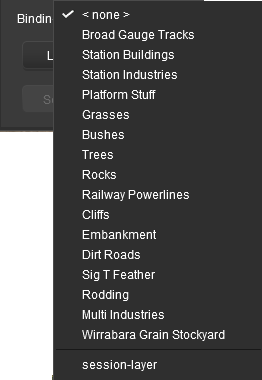 |
|
|||||||||||
| As an example, the image below shows what you will see for a single object that has had:- | |||||||||
 |
|
||||||||
 |
More information on creating, editing and using Layers can be found on the Trainz Wiki at:- |
The Tools Palette |
|
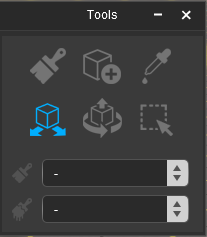 |
|
 |
The Context Tool is attached as an icon to a selected or newly placed object. The icon and its Context menu will vary according to the type of object. |
|
The Brush Tool
| Keyboard Shortcut: W | The Brush Tool "paints" the ground height, ground textures, effect layers and scrapbook scenes in a route |
 |
|
|||||||||||||||||||
| The Brush Targets Ground Height , Scrapbook Data and Effect Layers have a second drop down menu that controls the Brush Action. |
|
The Placement Tool
| Keyboard Shortcut: E | The Placement Tool adds objects to a route |
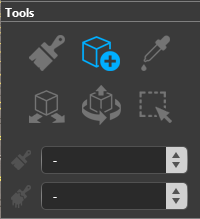 |
|
||||||||||||||||||||||
The Eyedropper Tool
| Keyboard Shortcut: R | The Eyedropper Tool identifies and selects objects in a route |
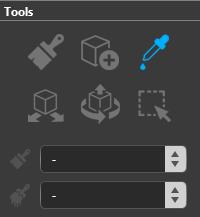 |
|
The Free Move Tool
| Keyboard Shortcut: S | The Free Move Tool moves objects around a route |
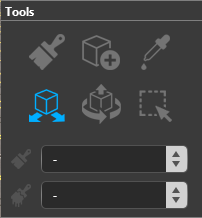 |
|
The Fine Adjustment Tool
| Keyboard Shortcut: D | The Fine Adjustment Tool makes 3D adjustments (XYZ position and rotations) to objects in a route |
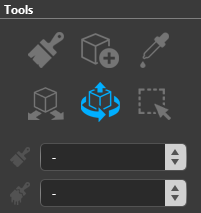 |
|
||||||||||||||||
|
The Marquee Tool
| Keyboard Shortcut: F | The Marquee Tool selects the content in areas of a route, creates and deletes baseboards and sets their properties. It can also be used in creating Scrapbooks |
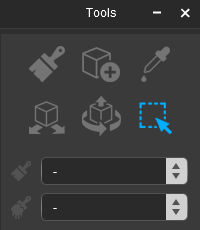 |
The Marquee Tool draws out a rectangular area, the Marquee Selection Area, on the route. Any objects (including Ground Heights, Ground Textures and Effect Layers) that are inside the Marquee Selection Area or touched by its boundary will be selected. The contents of the area can then be moved, rotated, deleted or copied to a Scrapbook.
|
The Tool Options Palette |
| This palette is used by various tools to set controls and parameters. For a detailed description of all the options presented by the Tools Palette for the different tools, see the Trainz Wiki page |
| All the Tool Options controls and settings are shown in the image below. The controls are shown in the image as being "inactive". An "active" control will have its icon (to the left of the control name) shown in Gold . Different Brush Types and Brush Actions will activate different controls. | |||||||||||||||||||||||||||||||||||||||||||||||||||||||||||||||
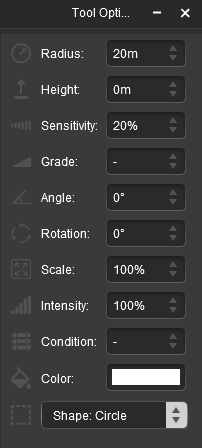 |
|
||||||||||||||||||||||||||||||||||||||||||||||||||||||||||||||
|
Tool Options Popups |
| Most of the data entry boxes in the Tool Options Palette have a Popup Menu. Right Click inside a box to bring up its menu |
Common Options:- Radius Angle Sensitivity Rotation Scale Intensity
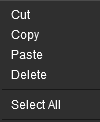 |
|
|
Height
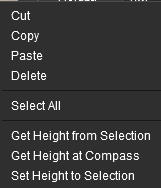 |
|
|||||||||
Grade
 |
|
||||||||||
Condition
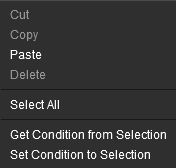 |
|
||||||||||
Tool Options Active Controls |
| Different Tool Palette and Brush Type selections will activate different option controls |
Some examples of when the controls will become active are:-
| If a Brush Tool is selected then the exact controls that will be active will vary between the different brushes and brush actions. For example, selecting the Ground Height Brush and the Set Height brush action will active the following Tool Options. |
 |
|
|||||||||||||||||||
| If a Track Spline Object is selected with the Free Move Tool or the Fine Adjustment Tool then the following Tool Options will become active. |
 |
|
||||||||||||||||||
| If the Scrapbook Data Brush is selected to paint the current Scrapbook into the route then certain controls that will affect the painting of the Scrapbook will, depending on the brush action selected, become active. |
Scrapbook Brush 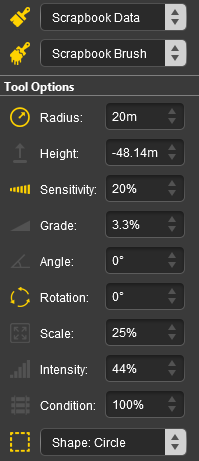 |
Scrapbook Clone  |
|
|||||||||||||||||||||||||||||||||||||||
 |
More examples and more detailed descriptions of the Tool Options Palette Active Controls can be found on the Trainz Wiki at:- |
The Assets Palette |
| This palette is used by various tools and other palettes to select and identify assets and objects. It includes a filter function to narrow down the search and selection process. |
Using the Asset Filters
| The Assets Palette provides filter options that can be used with the Placement Tool, Free Move Tool, Fine Adjustment Tool, Marquee Tool and the Eyedropper Tool. |
|
Steps:
The first filter option controls where the filters are applied.
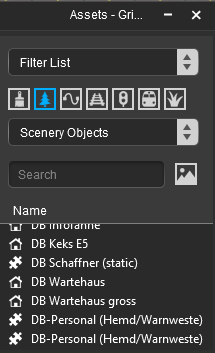 |
|
| It is recommended that you also make use of either Step |
| The second filter is optional and identifies the type of asset that will be selected by the filter. This option can be selected by a Left Click on a icon that represents the different types of assets or selecting the type of asset from a drop down list. |
Options: Choose from:-
|
OR |
|
| The third filter is also optional. You can enter a string of text characters that will be used to search the asset names and their descriptions for a match. Those assets that return a positive match, together with a positive asset type, will be shown in the filter name list. |
|
An example: To search for all Scenery Objects that have the text string "barn" in their name or description:-
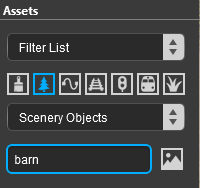 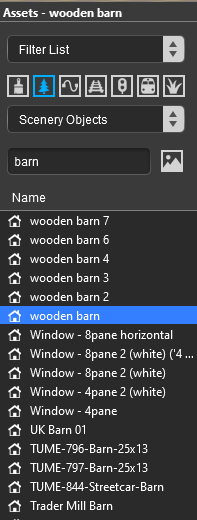 |
|
||||||||||||||||||||||||||||||
Expanding the Assets Name List View |
The list of asset names shown below the filter controls can be expanded to provide more information about each asset.

|
Just like in Content Manager, additional columns can be added, removed, resized and moved to a different position.
|
|||||||||||||||||||||||||
|
Thumbnail View |
As an alternative to the list view of filtered assets, there is a thumbnail view option. Again this works best when the Assets Palette has been undocked.
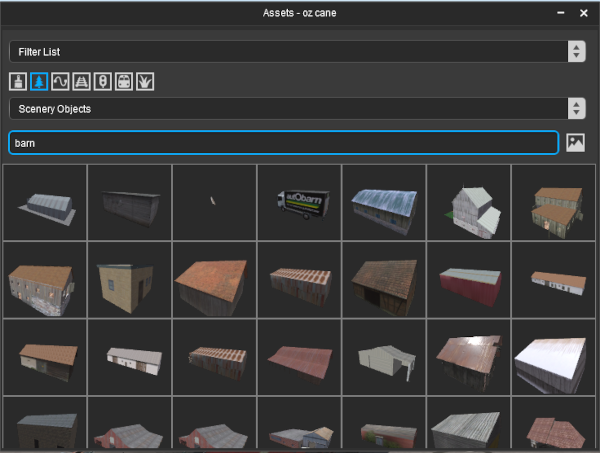 |
|
|||||||||||||
The Layers Palette |
| This palette is used to manage layers, both object (route and session) and effect (TurfFX, clutter and water) layers | |
| It can create, rename, merge, delete, move, hide/show and lock/unlock layers and set the Active Layer |
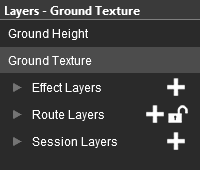 |
The Layers Palette will show all the layers in their groups (Effect, Route and Session) plus the Ground Height and Ground Textures special "layers". In the image on the left all the layer groups have been minimised (the arrowhead symbol to the left of each group name is pointing to the right).
|
Lock the Route Layer Group
| All the Route Layers can be locked against accidental alteration. | ||
The Route Layers group has a open padlock icon next to its name - shown as ![]() (unlocked).
(unlocked).
|
||||||
Open a Layer Group
To the left of each group name is a small arrowhead pointing to the right. Left Click on the arrowhead to open up the group.
 |
The image on the left shows that the Session Layers is open and its individual layers are now displayed. To close or minimise the group Left Click on the arrowhead again. The image shows that the Session Layers contains 3 individual layers:-
|
Add a New Layer
| You cannot create new layer groups but you can add new layers to a existing group. |
| Each layer group has a |
Renaming a Layer
 |
|
|||||||
|
Deleting a Layer
|
 |
|
|||||||||||||||
Moving a Layer
| Layers can be individually moved up and down within the same layer group or between the Route Layers and the Session Layers groups. |
|
|||||||||||||||
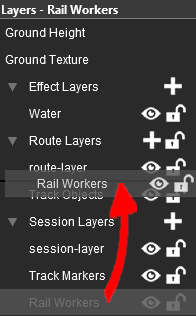 Moving the Rail Workers layer up one level |
|
|||||||||||||||
|
||||||||||||||||||||||||||
Merging a Layer
 |
Right Click on a layer name and select Merge Layer Up from the popup menu.
|
Hiding Layers
| Each individual layer has an Eye icon that controls the state (visible or hidden) of that layer |
Left Click on the Eye icon to toggle its state between visible and hidden.
|
|
||||||||||||||||||
Locking Layers
| Each individual layer has a Padlock icon that controls the state (locked or unlocked) of that layer |
Left Click on the Padlock icon to toggle its state between locked and unlocked
|
|
||||||||||||||||||
Setting the Active Layer
| The Active Layer is the layer where new objects will be automatically added when using the Placement Tool | |
| Only Session and Route layers can be selected as the Active Layer |
| The active layer is shown in the palette with its name on a blue background. In the image below the Rail Workers layer from the Session Layers Group is the current Active Layer. The name of the current Active Layer is also shown in the Layer Palette Title Bar. |
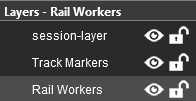 |
|
||||||||
Move an Object to Another Layer
| Use the Info Palette to move objects to another layer. |
| The Info Palette will show the layer assigned to the currently selected object. An object is selected by using the Free Move Tool (the S key) or the Fine Adjustment Tool (the D key) found in the Tools Palette. |
||||||||||||||||||||
|
|
|
|||||||||||||||||||
The Scrapbook Palette |
|
| This palette manages the Scrapbooks that you have created yourself, installed from other sources (such as the DLS) or came installed with Trainz. It also controls which parts of a scrapbook are pasted or painted into a route. |
|
|
||||||||||||||||||||||||||||||||||
|
|
|||||||||||||||
Creating a New Scrapbook |
|
||||||||||||||||||||
|
When a new Scrapbook is created by a Cut or Copy , it will appear in the Scrapbook palette with some basic details.
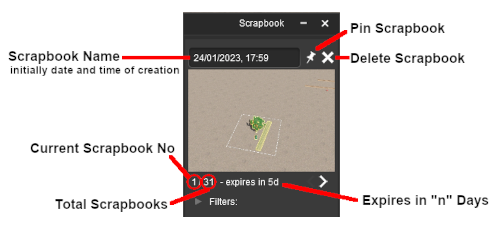 |
|
|||||||||||||||
|
|
|
 |
||||||||||
| Once a scrapbook has been Pinned it becomes an asset and will appear in Content Manager |

The scrapbook can be uploaded to the DLS and saved as a CDP file.
|
Painting or Pasting a Scrapbook |
| Existing Scrapbooks can be painted into a route using the Brush Tool (see the Trainz Wiki page When using the Brush Tool to paint a Scrapbook you will have a choice of two different brushes or Targets - the Scrapbook Brush and the Scrapbook Clone . The action of each brush will be controlled by its Tool Options Palette settings. |
Scrapbook Brush  |
Scrapbook Clone  |
|
||||||||||||||||||||||||||||||||||||||
|
|
||||||||||
Setting the Filters
|
||||||
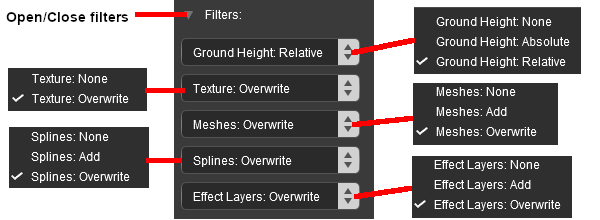
|
|
||||||||||||||||||||||||||||||||||||||||||||||||||||||||||||||||||||||||
The Asset Preview Palette |
| This palette gives a rotating 3D view of an asset that has been selected in the Assets Palette. It works with all assets except effect layers. |
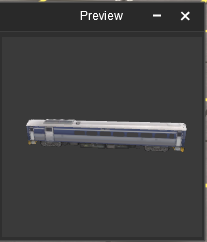 |
The Asset Preview Palette can be enlarged once it has been undocked. The current Surveyor 2.0 version has no display or control options and lacks the "zoom" and other features found in the Preview function of Content Manager. |
The Content Packages Palette |
| This palette is mainly intended for content creators, particularly MPS (Multi Player Surveyor) content. It helps manage, prepare and upload to the MPS Server a user created "Content Package". The web site for the TCCP (Trainz Content Creation Program) can be found at info.trainzsimulator.com/tccp |
|
|
The palette lists all the installed Content Packages that have assets available for use. Two special packages are included in the list:-
| All Installed Content which covers all offline (non-MPS) content, and | |
| multiplayersurveyor which includes all the default content on the live MPS Server |
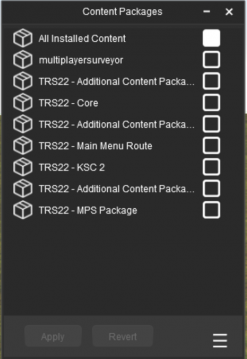 |
|
|||||||||||||||||||||
|
Content Package Details |
 |
|
|||||||
Some packages will display the message ![]()
If details are available then something like the following example will be shown.
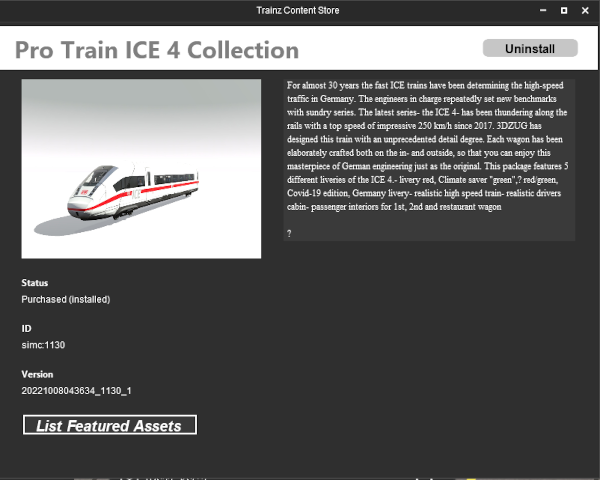 |
|
|||||||||||||||||
|
Testing the Packages |
| While you can manually select the packages to be enabled, an easier option may be to let the program perform that task. |
With or without any packages enabled, Left Click on the icon showing 3 horizontal bars (bottom right) to open a menu.

|
||||||||||
|
||||||||
Dealing with Unsupported Assets |
If you have manually selected and enabled the packages you want to include and have been shown a list of assets that are not supported by your selection, then you will need to identify the missing packages (if any) and add them manually.
|
||||||||||||||
| If you have used the Automatically Enable Required Packages option then any unsupported assets found will not belong to any installed packages. In this case you will need to create a new package using TCCP and add them to that package - see the Trainz Wiki Page at |
||||||||||||||
Apply and Upload |
Once you have enabled the required packages, you need to prepare the route for uploading to the live MPS Server
|
||||||||||||||
The next step is to upload the new package to the live MPS Server.
|
|||||||||||||||||
Trainz Wiki
 |
More Tutorials and Guides to Using Trainz |
This page was created by Trainz user pware in February 2023 and was last updated as shown below.

